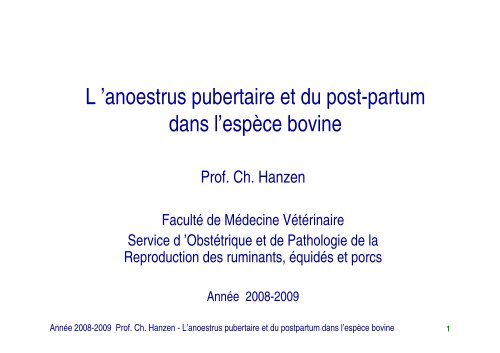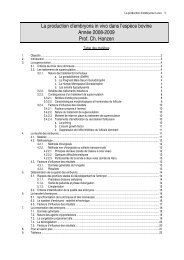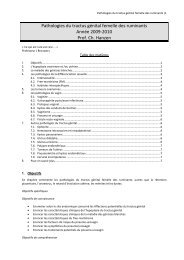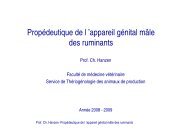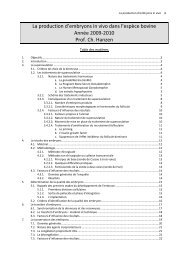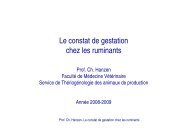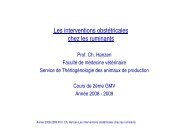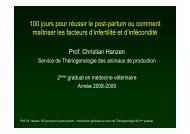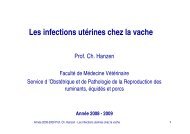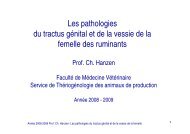L 'anoestrus pubertaire et du post-partum dans l' - Thériogénologie ...
L 'anoestrus pubertaire et du post-partum dans l' - Thériogénologie ...
L 'anoestrus pubertaire et du post-partum dans l' - Thériogénologie ...
You also want an ePaper? Increase the reach of your titles
YUMPU automatically turns print PDFs into web optimized ePapers that Google loves.
L ’anoestrus <strong>pubertaire</strong> <strong>et</strong> <strong>du</strong> <strong>post</strong>-<strong>partum</strong><br />
<strong>dans</strong> l’espèce bovine<br />
Prof. Ch. Hanzen<br />
Faculté de Médecine Vétérinaire<br />
Service d ’Obstétrique <strong>et</strong> de Pathologie de la<br />
Repro<strong>du</strong>ction des ruminants, équidés <strong>et</strong> porcs<br />
Année 2008-2009<br />
Année 2008-2009 Prof. Ch. Hanzen - L’anoestrus <strong>pubertaire</strong> <strong>et</strong> <strong>du</strong> <strong>post</strong><strong>partum</strong> <strong>dans</strong> l’espèce bovine 1
Objectifs<br />
Ce chapitre est le premier des deux consacrés à l’anoestrus<br />
(l’anoestrus <strong>pubertaire</strong> <strong>et</strong> <strong>du</strong> <strong>post</strong><strong>partum</strong> <strong>dans</strong> l’espèce bovine ;<br />
l’anoestrus saisonnier des p<strong>et</strong>its ruminants). Ils ont pour<br />
objectifs de définir les divers types d’anoestrus, d’en préciser la<br />
symptomatologie clinique, les facteurs responsables <strong>et</strong> les<br />
principes généraux de leur traitement. Leur compréhension<br />
n’est pas aisée.<br />
Elle implique une parfaite connaissance <strong>et</strong> compréhension de la<br />
physiologie hormonale <strong>du</strong> cycle sexuel <strong>et</strong> de la croissance<br />
folliculaire..<br />
Année 2008-2009 Prof. Ch. Hanzen - L’anoestrus <strong>pubertaire</strong> <strong>et</strong> <strong>du</strong> <strong>post</strong><strong>partum</strong> <strong>dans</strong> l’espèce bovine 2
Objectifs spécifiques de connaissance<br />
●<br />
●<br />
●<br />
●<br />
●<br />
●<br />
●<br />
●<br />
●<br />
●<br />
Définir l<strong>'anoestrus</strong><br />
Citer les trois principaux types d<strong>'anoestrus</strong> physiologiques <strong>et</strong> leur <strong>du</strong>rée<br />
Citer les deux types d<strong>'anoestrus</strong> pathologiques <strong>pubertaire</strong>s (fonctionnel <strong>et</strong><br />
congénital cad free martinisme <strong>et</strong> WHD)<br />
Enoncer trois facteurs responsables de l’anoestrus <strong>pubertaire</strong><br />
Citer trois facteurs responsables de l’anoestrus de détection.<br />
Citer trois situations d<strong>'anoestrus</strong> pathologiques <strong>du</strong> <strong>post</strong>-<strong>partum</strong><br />
Enoncer quatre facteurs responsables de l’anoestrus <strong>du</strong> <strong>post</strong><strong>partum</strong><br />
Enoncer les critères de diagnostic des anoestrus pathologiques <strong>pubertaire</strong><br />
Enoncer les critères de diagnostic de l<strong>'anoestrus</strong> fonctionnel <strong>pubertaire</strong><br />
Enoncer les critères de diagnostic de l<strong>'anoestrus</strong> fonctionnel <strong>du</strong> <strong>post</strong>-<strong>partum</strong><br />
Année 2008-2009 Prof. Ch. Hanzen - L’anoestrus <strong>pubertaire</strong> <strong>et</strong> <strong>du</strong> <strong>post</strong><strong>partum</strong> <strong>dans</strong> l’espèce bovine 3
Objectifs spécifiques de connaissance (suite)<br />
●<br />
●<br />
●<br />
●<br />
●<br />
●<br />
●<br />
●<br />
●<br />
Enoncer les critères de diagnostic des trois situations d<strong>'anoestrus</strong><br />
pathologiques <strong>du</strong> <strong>post</strong>-<strong>partum</strong><br />
Enoncer les critères de diagnostic de l<strong>'anoestrus</strong> de détection<br />
Enoncer les critères de diagnostic de l<strong>'anoestrus</strong> physiologique <strong>du</strong> <strong>post</strong><strong>partum</strong><br />
Citer les anoestrus qui peuvent relever de mesures zootechniques<br />
Citer trois mesures zootechniques pouvant prévenir ou corriger les anoestrus<br />
<strong>pubertaire</strong> <strong>et</strong> <strong>du</strong> <strong>post</strong><strong>partum</strong><br />
Citez les molécules utilisables pour la maîtrise des cycles chez les ruminants<br />
Décrire la méthode de mise en place d'un implant sous-cutané<br />
Décrire la méthode de mise en place d'une spirale vaginale<br />
Citer les associations hormonales perm<strong>et</strong>tant d’in<strong>du</strong>ire <strong>et</strong>/ou de synchroniser<br />
les chaleurs <strong>et</strong> ou les ovulations <strong>dans</strong> <strong>l'</strong>espèce bovine<br />
Année 2008-2009 Prof. Ch. Hanzen - L’anoestrus <strong>pubertaire</strong> <strong>et</strong> <strong>du</strong> <strong>post</strong><strong>partum</strong> <strong>dans</strong> l’espèce bovine 4
Objectifs spécifiques de compréhension<br />
●<br />
●<br />
●<br />
●<br />
●<br />
●<br />
●<br />
●<br />
●<br />
●<br />
Comparer au moyen d'un schéma les phases de la croissance folliculaire au cours<br />
<strong>du</strong> <strong>post</strong><strong>partum</strong> chez la vache laitière <strong>et</strong> allaitante au cours <strong>du</strong> <strong>post</strong><strong>partum</strong>.<br />
Expliquer au moyen d'un schéma le mécanisme hormonal de la reprise des cycles au<br />
cours <strong>du</strong> <strong>post</strong><strong>partum</strong> chez la vache.<br />
Expliquer la relation entre un des facteurs responsables de l’anoestrus <strong>pubertaire</strong> <strong>et</strong><br />
c<strong>et</strong> anoestrus.<br />
Expliquer la relation entre un des facteurs responsables de l’anoestrus <strong>du</strong><br />
<strong>post</strong><strong>partum</strong> <strong>et</strong> c<strong>et</strong> anoestrus.<br />
Comparer <strong>l'</strong>intérêt des critères de diagnostic des anoestrus<br />
Expliquez le mécanisme d'action des traitements zootechniques des anoestrus<br />
Comparer les voies d’administration des progestagènes utilisés en pratique pour la<br />
maîtrise des cycles<br />
Expliquez le mécanisme d'action des molécules utilisables pour la maîtrise des<br />
cycles chez les ruminants<br />
Représenter par un schéma le principe d'action des associations hormonales<br />
applicables chez des vaches ou génisses cyclées<br />
Expliquer le traitement hormonal adapté à chaque situation d<strong>'anoestrus</strong>.<br />
Année 2008-2009 Prof. Ch. Hanzen - L’anoestrus <strong>pubertaire</strong> <strong>et</strong> <strong>du</strong> <strong>post</strong><strong>partum</strong> <strong>dans</strong> l’espèce bovine 5
Objectifs spécifiques d’application<br />
●<br />
●<br />
●<br />
●<br />
au moyen des données d'une anamnèse, établir un diagnostic<br />
différentiel des anoestrus <strong>du</strong> <strong>post</strong><strong>partum</strong><br />
au moyen des données d'une anamnèse, établir un diagnostic<br />
différentiel des anoestrus <strong>pubertaire</strong>s<br />
Traiter chaque type d<strong>'anoestrus</strong> au moyen <strong>du</strong> traitement<br />
zootechnique le plus approprié (le cas échéant)<br />
Traiter chaque type d<strong>'anoestrus</strong> au moyen <strong>du</strong> traitement<br />
hormonal approprié (le cas échéant)<br />
Année 2008-2009 Prof. Ch. Hanzen - L’anoestrus <strong>pubertaire</strong> <strong>et</strong> <strong>du</strong> <strong>post</strong><strong>partum</strong> <strong>dans</strong> l’espèce bovine 6
Les anoestrus<br />
● Anoestrus de détection<br />
● Anoestrus physiologique<br />
anoestrus physiologique pré<strong>pubertaire</strong> :<br />
anoestrus physiologique <strong>du</strong> <strong>post</strong><strong>partum</strong> :<br />
anoestrus saisonnier : jument, brebis <strong>et</strong> chèvre >> vache ou truie<br />
anoestrus de gestation<br />
anoestrus ménopausique<br />
● Anoestrus fonctionnel<br />
● Anoestrus pathologique<br />
anoestrus pathologique <strong>pubertaire</strong> :<br />
• Anoestrus pathologique fonctionnel <strong>pubertaire</strong><br />
• freemartinisme<br />
• certains cas de maladie de génisses blanches<br />
anoestrus pathologique <strong>du</strong> <strong>post</strong><strong>partum</strong> :<br />
• anoestrus pathologique fonctionnel<br />
• kyste ovarien<br />
• pyomètre ...<br />
Année 2008-2009 Prof. Ch. Hanzen - L’anoestrus <strong>pubertaire</strong> <strong>et</strong> <strong>du</strong> <strong>post</strong><strong>partum</strong> <strong>dans</strong> l’espèce bovine 7
Les anoestrus <strong>pubertaire</strong><br />
Pas de détection<br />
de chaleurs chez<br />
un animal cyclé<br />
Période d ’attente<br />
14 mois <br />
A. de détection<br />
A. pathologique fonctionnel<br />
A. fonctionnel<br />
A. physiol.<br />
Période de croissance<br />
pre<strong>pubertaire</strong> (< 12 mois)<br />
Pas de croissance folliculaire<br />
régulière avec ovulation<br />
<strong>et</strong> corps jaune<br />
12 à 14 mois<br />
Pas de croissance folliculaire régulière<br />
avec ovulation <strong>et</strong> corps jaune<br />
> 14 mois <strong>post</strong> naiss<br />
Année 2008-2009 Prof. Ch. Hanzen - L’anoestrus <strong>pubertaire</strong> <strong>et</strong> <strong>du</strong> <strong>post</strong><strong>partum</strong> <strong>dans</strong> l’espèce bovine 8
Les anoestrus <strong>du</strong> <strong>post</strong>-<strong>partum</strong><br />
Pas de détection<br />
de chaleurs chez<br />
un animal cyclé<br />
Période d ’attente<br />
50 jours <br />
A. de détection<br />
pyomètre<br />
A. pathologique fonctionnel<br />
A. fonctionnel<br />
kystes<br />
A. physiol.<br />
Pas de réponse à la GnRH<br />
Pas de croissance<br />
folliculaire régulière<br />
avec ovulation<br />
<strong>et</strong> corps jaune<br />
Pas de croissance<br />
folliculaire régulière<br />
avec ovulation<br />
<strong>et</strong> corps jaune<br />
> 50 jours PP<br />
Année 2008-2009 Prof. Ch. Hanzen - L’anoestrus <strong>pubertaire</strong> <strong>et</strong> <strong>du</strong> <strong>post</strong><strong>partum</strong> <strong>dans</strong> l’espèce bovine 9
Periods of cycling or not cycling in heifers<br />
Birth<br />
Puberty 12 mths<br />
First AI : 14 mths<br />
C1 : 24 mths<br />
Beginning of pregnancy<br />
Period of<br />
physiological<br />
anoestrus<br />
Waiting<br />
period:<br />
cycles<br />
Repro<strong>du</strong>ction<br />
Period:<br />
cycles<br />
Period of<br />
Physiological<br />
anoestrus<br />
Année 2008-2009 Prof. Ch. Hanzen - L’anoestrus <strong>pubertaire</strong> <strong>et</strong> <strong>du</strong> <strong>post</strong><strong>partum</strong> <strong>dans</strong> l’espèce bovine 10
Periods of cycling or not cycling in cows<br />
Calving<br />
Waiting<br />
period<br />
15d : dairy cows<br />
30d : beef cows<br />
First AI : 50d<br />
Begining<br />
of pregnancy<br />
90d<br />
C2 : 12 mths<br />
Period of<br />
physiological<br />
anoestrus<br />
Period of<br />
Functionnal<br />
anoestrus<br />
Repro<strong>du</strong>ction<br />
Period:<br />
cycles<br />
Period of<br />
Physiological<br />
anoestrus<br />
Année 2008-2009 Prof. Ch. Hanzen - L’anoestrus <strong>pubertaire</strong> <strong>et</strong> <strong>du</strong> <strong>post</strong><strong>partum</strong> <strong>dans</strong> l’espèce bovine 11
Et donc 3 aspects cliniques des anoestrus<br />
● « comportemental »<br />
● « hormonal »<br />
● « folliculaire »<br />
Année 2008-2009 Prof. Ch. Hanzen - L’anoestrus <strong>pubertaire</strong> <strong>et</strong> <strong>du</strong> <strong>post</strong><strong>partum</strong> <strong>dans</strong> l’espèce bovine 12
% de vaches laitières cyclées ou en anoestrus<br />
(dosage de progestérone à 51 <strong>et</strong> 63 jours <strong>post</strong><strong>partum</strong>)<br />
(Thatcher <strong>et</strong> al. Quebec mai 2002)<br />
Status Primiparous Multiparous<br />
Total<br />
Cyclic<br />
112<br />
(64.37 %)<br />
270<br />
(83.08 %)<br />
382<br />
(76.55 %)<br />
Anestrus<br />
62<br />
(35.63 %)<br />
55<br />
(16.92 %)<br />
117<br />
(23.45 %)<br />
Total<br />
174<br />
(34.87 %)<br />
325<br />
(65.13 %)<br />
499<br />
(100.0 %)<br />
Année 2008-2009 Prof. Ch. Hanzen - L’anoestrus <strong>pubertaire</strong> <strong>et</strong> <strong>du</strong> <strong>post</strong><strong>partum</strong> <strong>dans</strong> l’espèce bovine 13
Aspects cliniques de l ’anoestrus <strong>pubertaire</strong><br />
● Pas de follicule cavitaire à la naissance<br />
● Période de croissance : naissance - 6 mois<br />
● Période pré<strong>pubertaire</strong> > 6 mois – puberté (12 mois)<br />
● Puberté proprement dite (12 mois)<br />
Année 2008-2009 Prof. Ch. Hanzen - L’anoestrus <strong>pubertaire</strong> <strong>et</strong> <strong>du</strong> <strong>post</strong><strong>partum</strong> <strong>dans</strong> l’espèce bovine 14
Aspects cliniques de l ’anoestrus <strong>pubertaire</strong> : définitions<br />
● Puberté : ensemble des phénomènes anatomiques, histologiques<br />
<strong>et</strong> hormonaux rendant possible la repro<strong>du</strong>ction d'un animal<br />
● N : 6 à 24 mois (12 mois)<br />
● Zootechnique : 14 mois (vêlage à deux ans)<br />
Année 2008-2009 Prof. Ch. Hanzen - L’anoestrus <strong>pubertaire</strong> <strong>et</strong> <strong>du</strong> <strong>post</strong><strong>partum</strong> <strong>dans</strong> l’espèce bovine 15
Aspects cliniques de l ’anoestrus <strong>pubertaire</strong> : période<br />
pré<strong>pubertaire</strong> (6 à 12 mois) vs puberté<br />
● Croissance sous la forme de vagues<br />
● La plupart des follicules sont anovulatoires<br />
● Morphologie différente <strong>du</strong> follicule dominant<br />
Phase de croissance <strong>et</strong> de plateau <strong>du</strong> follicule dominant plus courte<br />
Diamètre max moyen <strong>du</strong> follicule dominant inférieur<br />
Intervalle entre deux vagues plus court<br />
● Cycle de <strong>du</strong>rée plus courte<br />
● Corps jaune de taille inférieure : 19,9 mm vs 25.8 mm<br />
● Synthèse moindre de progestérone par le corps jaune<br />
● Commun dénominateur : synthèse moindre de LH<br />
Année 2008-2009 Prof. Ch. Hanzen - L’anoestrus <strong>pubertaire</strong> <strong>et</strong> <strong>du</strong> <strong>post</strong><strong>partum</strong> <strong>dans</strong> l’espèce bovine 16
Année 2008-2009 Prof. Ch. Hanzen - L’anoestrus <strong>pubertaire</strong> <strong>et</strong> <strong>du</strong> <strong>post</strong><strong>partum</strong> <strong>dans</strong> l’espèce bovine 17
A. folliculaire<br />
Phase statique<br />
A. folliculaire<br />
Phase dynamique<br />
FD<br />
A. folliculaire<br />
Phase de devenir<br />
FK<br />
50 %<br />
20 %<br />
Anoestrus<br />
« folliculaire »<br />
<strong>du</strong> <strong>post</strong>-<strong>partum</strong><br />
(paragraphe 4.2.)<br />
< 4 mm<br />
A<br />
30 %<br />
Vache laitière<br />
0 7 12 20 à .....<br />
FD<br />
20 %<br />
FK<br />
A<br />
Vache<br />
allaitante<br />
80 %<br />
Année 2008-2009 Prof. Ch. Hanzen - L’anoestrus <strong>pubertaire</strong> <strong>et</strong> <strong>du</strong> <strong>post</strong><strong>partum</strong> <strong>dans</strong> l’espèce bovine 18
Année 2008-2009 Prof. Ch. Hanzen - L’anoestrus <strong>pubertaire</strong> <strong>et</strong> <strong>du</strong> <strong>post</strong><strong>partum</strong> <strong>dans</strong> l’espèce bovine 19
Evolution au cours <strong>du</strong> temps en fonction <strong>du</strong> niveau de pro<strong>du</strong>ction laitière de la<br />
fréquence d’ovaires inactifs (pas de structure ovarienne à 7 jours d’intervalle entre<br />
J45 <strong>et</strong> J70) <strong>et</strong> de kystes ovariens (structure > 20 mm lors de l’un ou l’autre des 3<br />
examens à 7 j d’intevalle entre J45 <strong>et</strong> J70) <strong>dans</strong> 4 fermes laitières.<br />
(Lopez-Gatius Theriogenology 2003)<br />
12<br />
10<br />
8<br />
6<br />
4<br />
2<br />
0<br />
1991 1992 1993 1994 1995 1996 1997 1998 1999 2000 Tot<br />
Année 2008-2009 Prof. Ch. Hanzen - L’anoestrus <strong>pubertaire</strong> <strong>et</strong> <strong>du</strong> <strong>post</strong><strong>partum</strong> <strong>dans</strong> l’espèce bovine 20
Hormonologie <strong>du</strong> <strong>post</strong><strong>partum</strong><br />
Schéma général<br />
ILP<br />
SLP<br />
Gestation Phase 1 (LH) Phase 2 (P4)<br />
75 à 90 %<br />
< 50 jours<br />
LH<br />
FSH<br />
Oest<br />
Année 2008-2009 Prof. Ch. Hanzen - L’anoestrus <strong>pubertaire</strong> <strong>et</strong> <strong>du</strong> <strong>post</strong><strong>partum</strong> <strong>dans</strong> l’espèce bovine 21
Année 2008-2009 Prof. Ch. Hanzen - L’anoestrus <strong>pubertaire</strong> <strong>et</strong> <strong>du</strong> <strong>post</strong><strong>partum</strong> <strong>dans</strong> l’espèce bovine 22
Etiologie de l ’anoestrus <strong>pubertaire</strong><br />
● Alimentation : puberté = acquisition d ’un poids à un âge donné<br />
● Environnement social : taille <strong>du</strong> troupeau, mâle ...<br />
● Conditions sanitaires<br />
pathologies néonatales<br />
traitements antiparasitaires<br />
Plans de vaccination<br />
● Recommandations : suivi de la croissance<br />
Année 2008-2009 Prof. Ch. Hanzen - L’anoestrus <strong>pubertaire</strong> <strong>et</strong> <strong>du</strong> <strong>post</strong><strong>partum</strong> <strong>dans</strong> l’espèce bovine 23
Année 2008-2009 Prof. Ch. Hanzen - L’anoestrus <strong>pubertaire</strong> <strong>et</strong> <strong>du</strong> <strong>post</strong><strong>partum</strong> <strong>dans</strong> l’espèce bovine 24
Etiologie de l ’anoestrus <strong>du</strong> PP<br />
● Facteurs propres à l’animal<br />
N° de lactation : primipares > pluripares<br />
Caractère allaitant ou lactant : essentiel<br />
Fréquence des têtées<br />
● Facteurs d’environnement<br />
Présence d’un mâle<br />
Saison : anoestrus moins long si lumière : comparer vêlages de<br />
printemps <strong>et</strong> d ’hiver. Mécanisme <br />
Alimentation : balance énergétique négative<br />
Mécanisme <br />
Année 2008-2009 Prof. Ch. Hanzen - L’anoestrus <strong>pubertaire</strong> <strong>et</strong> <strong>du</strong> <strong>post</strong><strong>partum</strong> <strong>dans</strong> l’espèce bovine 25
De l’allaitement : Mammifère vous avez dit mammifère...<br />
En 1758, Linné inventa le terme mammifère nommant ainsi toute<br />
une classe d ’animaux d ’après un trait (les glandes mammaires<br />
lactifères) que les femmes seules possédaient. Linné aurait pu<br />
choisir le système pileux par exemple qui eut été une meilleure<br />
caractéristique physique. Engagé <strong>dans</strong> une « guerre » contre les<br />
nourrices, il préféra la première solution croyant ce faisant assigner<br />
les femmes à rester <strong>dans</strong> leurs foyers...<br />
Année 2008-2009 Prof. Ch. Hanzen - L’anoestrus <strong>pubertaire</strong> <strong>et</strong> <strong>du</strong> <strong>post</strong><strong>partum</strong> <strong>dans</strong> l’espèce bovine 26
Gravure <strong>du</strong> XVIIIème : nourrice <strong>du</strong> fils de Gabrielle d ’Estrées, maîtresse d ’Henri IV<br />
Année 2008-2009 Prof. Ch. Hanzen - L’anoestrus <strong>pubertaire</strong> <strong>et</strong> <strong>du</strong> <strong>post</strong><strong>partum</strong> <strong>dans</strong> l’espèce bovine 27
Mécanisme inhibiteur de la succion<br />
● Eff<strong>et</strong> sur la phase 1 > phase 2<br />
● Eff<strong>et</strong> sur la LH > FSH<br />
● Eff<strong>et</strong> diminue avec le temps<br />
● Prolactine, corticoïdes, opioïdes endogènes <br />
Année 2008-2009 Prof. Ch. Hanzen - L’anoestrus <strong>pubertaire</strong> <strong>et</strong> <strong>du</strong> <strong>post</strong><strong>partum</strong> <strong>dans</strong> l’espèce bovine 28
De l’alimentation : key notes<br />
● Manque de définition des régimes alimentaires évalués<br />
● Paramètres d’évaluation des eff<strong>et</strong>s fort différents<br />
AGNE, leptine<br />
Adipocytes prélevés par biopsie, DEC<br />
● Relations avec pro<strong>du</strong>ction laitière <strong>et</strong> capacité d’ingestion pas toujours étudiées<br />
● Impact majeur des apports en énergie (notion de BE)<br />
sur la croissance folliculaire<br />
sur l’activité lutéale<br />
eff<strong>et</strong> majeur d’un suivi de l’EC<br />
eff<strong>et</strong> majeur d’un suivi de la Prod Lait <strong>et</strong> de ses composants<br />
● Mécanismes encore à l’étude :<br />
LH<br />
AGNE, leptine , insuline, IGF<br />
Année 2008-2009 Prof. Ch. Hanzen - L’anoestrus <strong>pubertaire</strong> <strong>et</strong> <strong>du</strong> <strong>post</strong><strong>partum</strong> <strong>dans</strong> l’espèce bovine 29
Percentage of cows in anestrus based on body condition<br />
scores collected at 1st GnRH of the Ovsynch/TAI protocol.<br />
70<br />
60<br />
50<br />
40<br />
30<br />
20<br />
10<br />
0<br />
2 2.5 3 3.5 4 4.5<br />
Body condition score<br />
Année 2008-2009 Prof. Ch. Hanzen - L’anoestrus <strong>pubertaire</strong> <strong>et</strong> <strong>du</strong> <strong>post</strong><strong>partum</strong> <strong>dans</strong> l’espèce bovine 30
PL, capacité d'ingestion <strong>et</strong> EC au cours <strong>du</strong> PP<br />
Kgs<br />
45 5<br />
Période d'insémination<br />
40<br />
4,5<br />
35<br />
30<br />
25<br />
20<br />
15<br />
10<br />
5<br />
0<br />
1 4 8 12 16 20 24 28 32 36 40 44 48 52<br />
4<br />
3,5<br />
3<br />
2,5<br />
2<br />
1,5<br />
1<br />
semaines<br />
Année 2008-2009 Prof. Ch. Hanzen - L’anoestrus <strong>pubertaire</strong> <strong>et</strong> <strong>du</strong> <strong>post</strong><strong>partum</strong> <strong>dans</strong> l’espèce bovine 31
BE = Econsommée – (Eentr<strong>et</strong>ien + Elactation)<br />
45<br />
35<br />
BE <strong>et</strong> E lactation (Mcal/j)<br />
Pro<strong>du</strong>ction laitière (kg/j)<br />
25<br />
15<br />
5<br />
-5<br />
BE min<br />
Ovulation<br />
5 10 15 20 25<br />
-15<br />
-25<br />
Jours <strong>post</strong>-<strong>partum</strong><br />
ENVAlfort<br />
Année 2008-2009 Prof. Ch. Hanzen - L’anoestrus <strong>pubertaire</strong> <strong>et</strong> <strong>du</strong> <strong>post</strong><strong>partum</strong> <strong>dans</strong> l’espèce bovine 32
Alimentation <strong>et</strong> croissance folliculaire (US)<br />
● BE <strong>et</strong> croissance folliculaire<br />
BE + : augmentation <strong>du</strong> n de follicules 10 à 15 mm<br />
BE - : recrutement toujours présent<br />
Ovulation plus fréquente si début de la croissance après plutôt<br />
qu’avant le moment de la BE - maximale<br />
Ovulation plus fréquente si <strong>du</strong>rée de la BE - plus courte<br />
● BE <strong>et</strong> activité lutéale<br />
Augmentation de la progestérone 10 jours en moyenne après le<br />
moment de la BE - maximale<br />
Synthèse de P4 > si BE + que –<br />
Année 2008-2009 Prof. Ch. Hanzen - L’anoestrus <strong>pubertaire</strong> <strong>et</strong> <strong>du</strong> <strong>post</strong><strong>partum</strong> <strong>dans</strong> l’espèce bovine 33
Gestion hormonale de la repro<strong>du</strong>ction (rappel)<br />
Synchronisation de la<br />
croissance folliculaire<br />
Régulation de la<br />
régression lutéale<br />
In<strong>du</strong>ction de<br />
l’ovulation<br />
GnRH<br />
Estradiol<br />
Progestérone<br />
Progestagènes<br />
Ponction folliculaire<br />
Prostaglandine F2a<br />
Progestagènes<br />
Progestérone<br />
GnRH<br />
Oestradiol<br />
hCG<br />
Année 2008-2009 Prof. Ch. Hanzen - L’anoestrus <strong>pubertaire</strong> <strong>et</strong> <strong>du</strong> <strong>post</strong><strong>partum</strong> <strong>dans</strong> l’espèce bovine 34
Hypothalamus<br />
Mélatonine<br />
Epiphyse<br />
GnRH<br />
Hypophyse<br />
FSH<br />
LH<br />
Oestrogènes<br />
Foll<br />
CJ<br />
Progestérone<br />
PGF2a<br />
Année 2008-2009 Prof. Ch. Hanzen - L’anoestrus <strong>pubertaire</strong> <strong>et</strong> <strong>du</strong> <strong>post</strong><strong>partum</strong> <strong>dans</strong> l’espèce bovine 35
Epiphyse<br />
Mélatonine : peptide<br />
Hypothalamus<br />
GnRH : polypeptide de 10 AA<br />
Hypophyse<br />
FSH : glycoprotéine<br />
LH : glycoprotéine<br />
Foll<br />
CJ<br />
Oestrogènes : stéroïde<br />
Progestérone : stéroïde<br />
PGF2a : dérivé acide arachidonique<br />
Année 2008-2009 Prof. Ch. Hanzen - L’anoestrus <strong>pubertaire</strong> <strong>et</strong> <strong>du</strong> <strong>post</strong><strong>partum</strong> <strong>dans</strong> l’espèce bovine 36
Traitements de l’anoestrus pathologique fonctionnel<br />
<strong>pubertaire</strong><br />
<strong>et</strong> <strong>du</strong> <strong>post</strong><strong>partum</strong><br />
(Cas des animaux non cyclés)<br />
1er choix : les progestagènes, la progestérone<br />
Année 2008-2009 Prof. Ch. Hanzen - L’anoestrus <strong>pubertaire</strong> <strong>et</strong> <strong>du</strong> <strong>post</strong><strong>partum</strong> <strong>dans</strong> l’espèce bovine 37
Traitements des anoestrus pathologiques <strong>du</strong> <strong>post</strong>-<strong>partum</strong> (APPP<br />
<strong>et</strong> APP) <strong>et</strong> <strong>pubertaire</strong> <strong>et</strong> des anoestrus de détection (AD)<br />
● Etape 1 : diagnostic différentiel entre AP <strong>et</strong> AD<br />
Si AD : cas des animaux cyclés : PGF<br />
Si AP : voir étape 2<br />
● Etape 2 : diagnostic différentiel entre anoestrus pathologique<br />
fonctionnel, kyste ou pyomètre<br />
Kyste<br />
Pyomètre<br />
Anoestrus pathologique fonctionnel (APFPP <strong>et</strong> APFP)<br />
Année 2008-2009 Prof. Ch. Hanzen - L’anoestrus <strong>pubertaire</strong> <strong>et</strong> <strong>du</strong> <strong>post</strong><strong>partum</strong> <strong>dans</strong> l’espèce bovine 38
Traitements de l ’anoestrus pathologique fonctionnel<br />
● Traitements zootechniques<br />
Allaitement<br />
Alimentation<br />
Eff<strong>et</strong> mâle<br />
● Traitements hormonaux<br />
Gonadolibérine<br />
Progestagènes<br />
Année 2008-2009 Prof. Ch. Hanzen - L’anoestrus <strong>pubertaire</strong> <strong>et</strong> <strong>du</strong> <strong>post</strong><strong>partum</strong> <strong>dans</strong> l’espèce bovine 39
Les stratégies d’allaitement<br />
● Nature<br />
au vêlage<br />
30 à 80 jours suivant la naissance<br />
deux périodes journalières de 30 à 60 minutes pendant au moins<br />
une dizaine de jours<br />
sevrage de 48 heures avant la PR<br />
● Avantages <strong>et</strong> inconvénients<br />
eff<strong>et</strong>s positifs sur les performances de repro<strong>du</strong>ction (primipares<br />
surtout)<br />
meilleure surveillance des veaux<br />
pas d ’eff<strong>et</strong> à long terme sur la croissance des veaux<br />
Année 2008-2009 Prof. Ch. Hanzen - L’anoestrus <strong>pubertaire</strong> <strong>et</strong> <strong>du</strong> <strong>post</strong><strong>partum</strong> <strong>dans</strong> l’espèce bovine 40
La GnRH (pour mémoire…)<br />
● GnRH : J 7 à J 10 (VL) <strong>et</strong> J 20 à J 30 (VA)<br />
eff<strong>et</strong> potentiel si follicule > 10 mm<br />
● GnRH : J 7 à J 34 <strong>et</strong> PGF 10 jours plus tard<br />
eff<strong>et</strong>s contradictoires directs ou indirects sur fertilité<br />
eff<strong>et</strong>s plus n<strong>et</strong>s sur les vaches à problèmes<br />
• ré<strong>du</strong>ction de la fréquence des kystes <strong>et</strong> pyomètres<br />
• accélération de l ’involution utérine <br />
● Autres schémas : eff<strong>et</strong>s <br />
• injections répétées (/ 2 h) pendant 2 à 3 J<br />
• implants SC de GnRH<br />
Année 2008-2009 Prof. Ch. Hanzen - L’anoestrus <strong>pubertaire</strong> <strong>et</strong> <strong>du</strong> <strong>post</strong><strong>partum</strong> <strong>dans</strong> l’espèce bovine 41
Les progestagènes (traitement de choix de l’APF)<br />
Nature Voie Dose Durée (J)<br />
-------------------------------------------------------------------------------------------------------------------------------<br />
Progestérone IM 50 - 100 mg/j 3 - 13<br />
Vaginale (Eponge) 3 G 18 - 20<br />
Vaginale (PRID, CIDR) 1.5 - 2.3 g 6 - 18 (12 j )<br />
MAP Orale 0.1 - 1 g/j 10 - 24<br />
MGA Orale 0.5 - 1 mg 5 - 18<br />
SC (Implant) 500 mg 21<br />
CAP Orale 6 - 18 mg/j 9 - 20<br />
FGA SC Implant) 50 - 150 mg 10 - 16<br />
Vaginale (Eponge) 100 - 200 mg 9 - 20<br />
IM 2 mg / j 9 - 20<br />
Norgestom<strong>et</strong> SC (Implant) 2 - 18 mg 5 - 16 (9 j )<br />
IM 0.2 mg/j 21<br />
DHPA Orale 75 - 500 mg 9 - 20<br />
Nor<strong>et</strong>handrolone IM 5 - 7 mg/j 10 - 18<br />
SC (Implant) 250 - 500 mg 9 - 18<br />
----------------------------------------------------------------------------------------------------------------------------------<br />
Année 2008-2009 Prof. Ch. Hanzen - L’anoestrus <strong>pubertaire</strong> <strong>et</strong> <strong>du</strong> <strong>post</strong><strong>partum</strong> <strong>dans</strong> l’espèce bovine 42
Les progestagènes : Principe de leur eff<strong>et</strong> in<strong>du</strong>cteur<br />
Année 2008-2009 Prof. Ch. Hanzen - L’anoestrus <strong>pubertaire</strong> <strong>et</strong> <strong>du</strong> <strong>post</strong><strong>partum</strong> <strong>dans</strong> l’espèce bovine 43
La spirale vaginale <strong>et</strong> sa mise en place<br />
Progestérone : 1,5 g<br />
Délai d’attente <strong>dans</strong> le lait <strong>et</strong> la viande : 0 jour<br />
Remarque : interdiction de <strong>l'</strong>utilisation des oestrogènes à compter<br />
<strong>du</strong> 14 octobre 2006 (Décr<strong>et</strong> 2004-757 <strong>du</strong> 22/07/2004) <strong>et</strong> donc la<br />
spirale vaginale ne renferme plus de benzoate d’oestradiol<br />
Année 2008-2009 Prof. Ch. Hanzen - L’anoestrus <strong>pubertaire</strong> <strong>et</strong> <strong>du</strong> <strong>post</strong><strong>partum</strong> <strong>dans</strong> l’espèce bovine 44
Année 2008-2009 Prof. Ch. Hanzen - L’anoestrus <strong>pubertaire</strong> <strong>et</strong> <strong>du</strong> <strong>post</strong><strong>partum</strong> <strong>dans</strong> l’espèce bovine 45
Année 2008-2009 Prof. Ch. Hanzen - L’anoestrus <strong>pubertaire</strong> <strong>et</strong> <strong>du</strong> <strong>post</strong><strong>partum</strong> <strong>dans</strong> l’espèce bovine 46
Année 2008-2009 Prof. Ch. Hanzen - L’anoestrus <strong>pubertaire</strong> <strong>et</strong> <strong>du</strong> <strong>post</strong><strong>partum</strong> <strong>dans</strong> l’espèce bovine 47
Année 2008-2009 Prof. Ch. Hanzen - L’anoestrus <strong>pubertaire</strong> <strong>et</strong> <strong>du</strong> <strong>post</strong><strong>partum</strong> <strong>dans</strong> l’espèce bovine 48
Année 2008-2009 Prof. Ch. Hanzen - L’anoestrus <strong>pubertaire</strong> <strong>et</strong> <strong>du</strong> <strong>post</strong><strong>partum</strong> <strong>dans</strong> l’espèce bovine 49
Année 2008-2009 Prof. Ch. Hanzen - L’anoestrus <strong>pubertaire</strong> <strong>et</strong> <strong>du</strong> <strong>post</strong><strong>partum</strong> <strong>dans</strong> l’espèce bovine 50
Année 2008-2009 Prof. Ch. Hanzen - L’anoestrus <strong>pubertaire</strong> <strong>et</strong> <strong>du</strong> <strong>post</strong><strong>partum</strong> <strong>dans</strong> l’espèce bovine 51
Année 2008-2009 Prof. Ch. Hanzen - L’anoestrus <strong>pubertaire</strong> <strong>et</strong> <strong>du</strong> <strong>post</strong><strong>partum</strong> <strong>dans</strong> l’espèce bovine 52
Année 2008-2009 Prof. Ch. Hanzen - L’anoestrus <strong>pubertaire</strong> <strong>et</strong> <strong>du</strong> <strong>post</strong><strong>partum</strong> <strong>dans</strong> l’espèce bovine 53
Schéma de traitement au moyen d’une spirale<br />
(anoestrus pathologique fonctionnel <strong>du</strong> PP ou <strong>pubertaire</strong>)<br />
PRID / CIDR : 12 jours<br />
24 48 56 72 96<br />
PMSG 500 UI<br />
Année 2008-2009 Prof. Ch. Hanzen - L’anoestrus <strong>pubertaire</strong> <strong>et</strong> <strong>du</strong> <strong>post</strong><strong>partum</strong> <strong>dans</strong> l’espèce bovine 54
Année 2008-2009 Prof. Ch. Hanzen - L’anoestrus <strong>pubertaire</strong> <strong>et</strong> <strong>du</strong> <strong>post</strong><strong>partum</strong> <strong>dans</strong> l’espèce bovine 55
L ’implant sous-cutané : nouveau protocole<br />
Norgestom<strong>et</strong> : 3,3 mg<br />
Délai <strong>dans</strong> la viande : 15 jours<br />
Délai <strong>dans</strong> le lait : 0 jour<br />
Remarque : interdiction de <strong>l'</strong>utilisation des oestrogènes à compter<br />
<strong>du</strong> 14 octobre 2006 (Décr<strong>et</strong> 2004-757 <strong>du</strong> 22/07/2004) <strong>et</strong> donc la<br />
mise en place d’un implant ne peut plus s’accompagner de<br />
l’injection de valérate d’oestradiol<br />
Année 2008-2009 Prof. Ch. Hanzen - L’anoestrus <strong>pubertaire</strong> <strong>et</strong> <strong>du</strong> <strong>post</strong><strong>partum</strong> <strong>dans</strong> l’espèce bovine 56
Schéma de traitement au moyen d’un implant (Crestar SO ®)<br />
(anoestrus pathologique fonctionnel <strong>du</strong> PP)<br />
Buséréline<br />
10 µg<br />
PGF<br />
48 h<br />
eCG<br />
400-600 UI<br />
Implant : 9 -11 jours<br />
24 48 56 72 96<br />
Année 2008-2009 Prof. Ch. Hanzen - L’anoestrus <strong>pubertaire</strong> <strong>et</strong> <strong>du</strong> <strong>post</strong><strong>partum</strong> <strong>dans</strong> l’espèce bovine 57
Année 2008-2009 Prof. Ch. Hanzen - L’anoestrus <strong>pubertaire</strong> <strong>et</strong> <strong>du</strong> <strong>post</strong><strong>partum</strong> <strong>dans</strong> l’espèce bovine 58
Implant ou spirale <br />
● Choix de la spirale<br />
Plus facile à m<strong>et</strong>tre en place<br />
Plus facile à r<strong>et</strong>irer<br />
Prix<br />
Risque de vaginite<br />
Perte <br />
● Choix de l’implant<br />
Plus difficile à m<strong>et</strong>tre en place<br />
Plus difficile à r<strong>et</strong>irer<br />
Prix<br />
Application si pneumo-vagin, étroitesse vulvaire<br />
Perte <br />
Année 2008-2009 Prof. Ch. Hanzen - L’anoestrus <strong>pubertaire</strong> <strong>et</strong> <strong>du</strong> <strong>post</strong><strong>partum</strong> <strong>dans</strong> l’espèce bovine 59
Facteurs d ’influence<br />
● Environnement<br />
Alimentation<br />
• eff<strong>et</strong> favorable d ’un apport en énergie (flushing)<br />
2 mois avant <strong>et</strong> après le traitement<br />
• éviter changements alimentaires pendant le traitement<br />
Saison <br />
● Thérapeutiques<br />
Oestrogènes au début<br />
• meilleure résorption<br />
• stimulation folliculaire<br />
• eff<strong>et</strong> antilutéotrope<br />
PMSG à la fin : 400 à 700 UI selon races<br />
PGF<br />
Année 2008-2009 Prof. Ch. Hanzen - L’anoestrus <strong>pubertaire</strong> <strong>et</strong> <strong>du</strong> <strong>post</strong><strong>partum</strong> <strong>dans</strong> l’espèce bovine 60
Année 2008-2009 Prof. Ch. Hanzen - L’anoestrus <strong>pubertaire</strong> <strong>et</strong> <strong>du</strong> <strong>post</strong><strong>partum</strong> <strong>dans</strong> l’espèce bovine 61
Facteurs d ’influence : facteurs zootechniques<br />
● Sevrage<br />
● Eff<strong>et</strong> bénéfique si pratiqué pendant 24 à 48 heures au début ou à la<br />
fin <strong>du</strong> traitement<br />
● Le stade <strong>du</strong> <strong>post</strong><strong>partum</strong> (Hanzen <strong>et</strong> al. 1995)<br />
Mieux après qu ’avant 80 jours PP si spirale<br />
● Le stade <strong>pubertaire</strong> (Hanzen <strong>et</strong> al. 1995)<br />
Mieux après 480 jours de vie qu ’avant si implant<br />
● La politique d’insémination<br />
Mieux vaut 2 inséminations qu ’une seule<br />
Année 2008-2009 Prof. Ch. Hanzen - L’anoestrus <strong>pubertaire</strong> <strong>et</strong> <strong>du</strong> <strong>post</strong><strong>partum</strong> <strong>dans</strong> l’espèce bovine 62
Traitements de l’anoestrus de détection <strong>pubertaire</strong><br />
<strong>et</strong>/ou <strong>du</strong> <strong>post</strong><strong>partum</strong><br />
(Cas des animaux cyclés)<br />
1er choix : les prostaglandines<br />
Année 2008-2009 Prof. Ch. Hanzen - L’anoestrus <strong>pubertaire</strong> <strong>et</strong> <strong>du</strong> <strong>post</strong><strong>partum</strong> <strong>dans</strong> l’espèce bovine 63
Les prostaglandines : données générales<br />
● Quelques prostaglandines de type F …<br />
● Enregistrement d ’espèces<br />
● Doses d ’emploi<br />
● Voies d ’administration recommandées<br />
● Rési<strong>du</strong>s<br />
● Toxicité<br />
● Champs d ’application<br />
Année 2008-2009 Prof. Ch. Hanzen - L’anoestrus <strong>pubertaire</strong> <strong>et</strong> <strong>du</strong> <strong>post</strong><strong>partum</strong> <strong>dans</strong> l’espèce bovine 64
Quelques prostaglandines …<br />
(adapted from New developments in animal repro<strong>du</strong>ction and<br />
breeding . K.Smale, 1991 and from Compendium des médicaments<br />
AGIM, 1997)<br />
Composé<br />
Noms commerciaux<br />
---------------------------------------------------------------------------------------------------------<br />
Alfaprostol Gabbrostim Alphacept Alphabedyl<br />
Cloprostenol Planate Estrumate Uniandine<br />
Dinoprost Dinolytic Hormo P2alpha<br />
Luprostiol Prosolvin Prostapar Reprodin<br />
Tiaprost<br />
Iliren<br />
Etiproston Prostav<strong>et</strong> V<strong>et</strong>iprost<br />
Fenprostalène Synchrosept-B Bovilène<br />
Fluprostenol<br />
Equimate<br />
-----------------------------------------------------------------------------------------------------------<br />
Année 2008-2009 Prof. Ch. Hanzen - L’anoestrus <strong>pubertaire</strong> <strong>et</strong> <strong>du</strong> <strong>post</strong><strong>partum</strong> <strong>dans</strong> l’espèce bovine 65
Enregistrement d ’espèces ….<br />
(Compendium des médicaments AGIM, 1997)<br />
● Alfaprostol Gabbrostim bo (8 mg) cv po<br />
● Cloprostenol Planate po<br />
Estrumate<br />
bo (500 mcg)<br />
● Dinoprost Dinolytic bo (25 mg) cv po<br />
● Luprostiol Prosolvin bo (7,5 à 15 mg) cv po ca<br />
● Tiaprost Iliren bo (0,75 mg) cv po ov<br />
● Etiproston Prostav<strong>et</strong> bo (5 mg)<br />
Année 2008-2009 Prof. Ch. Hanzen - L’anoestrus <strong>pubertaire</strong> <strong>et</strong> <strong>du</strong> <strong>post</strong><strong>partum</strong> <strong>dans</strong> l’espèce bovine 66
Voies d ’administration ….<br />
(Compendium des médicaments AGIM, 1997)<br />
● Alfaprostol Gabbrostim IM<br />
● Cloprostenol Planate IM<br />
Estrumate<br />
IM<br />
● Dinoprost Dinolytic IM / SC<br />
● Luprostiol Prosolvin IM<br />
Prostapar<br />
IM<br />
● Tiaprost Iliren IM / SC / IV<br />
● Autres voies potentielles : périvulvaire, périanale (truie) : doses ré<strong>du</strong>ites de 1/2<br />
Année 2008-2009 Prof. Ch. Hanzen - L’anoestrus <strong>pubertaire</strong> <strong>et</strong> <strong>du</strong> <strong>post</strong><strong>partum</strong> <strong>dans</strong> l’espèce bovine 67
Rési<strong>du</strong>s (délais de consommation des animaux)<br />
(Compendium des médicaments AGIM, 1997)<br />
● Alfaprostol Gabbrostim 24 heures : lait <strong>et</strong> viande<br />
● Cloprostenol Planate 24 heures<br />
Estrumate 24 heures : viande<br />
0 heure : lait<br />
● Dinoprost Dinolytic 24 heures : lait <strong>et</strong> viande<br />
● Luprostiol Prosolvin 24 heures : viande<br />
0 heure : lait<br />
Prostapar 24 heures : viande<br />
● Tiaprost Iliren 48 heures : bo, po, ov<br />
96 heures : cv<br />
Année 2008-2009 Prof. Ch. Hanzen - L’anoestrus <strong>pubertaire</strong> <strong>et</strong> <strong>du</strong> <strong>post</strong><strong>partum</strong> <strong>dans</strong> l’espèce bovine 68
Eff<strong>et</strong>s secondaires….<br />
(Compendium des médicaments AGIM, 1997)<br />
● Espèce humaine : éviter le contact cutané<br />
femmes enceintes<br />
asthmatiques<br />
● Espèces animales : pas d ’eff<strong>et</strong>s secondaires<br />
Sensibilité plus grande des juments <strong>et</strong> truies<br />
Symptômes passagers : 10 à 15 minutes<br />
Nature : sudations, coliques, tachycardie, hyperthermie, salivation,<br />
polypnée, anxiété, polyurie ...<br />
Année 2008-2009 Prof. Ch. Hanzen - L’anoestrus <strong>pubertaire</strong> <strong>et</strong> <strong>du</strong> <strong>post</strong><strong>partum</strong> <strong>dans</strong> l’espèce bovine 69
Champs d’application des PGFs (vache)<br />
● Le plus souvent (<strong>et</strong> <strong>dans</strong> l ’ordre décroissant)<br />
Approche indivi<strong>du</strong>elle : in<strong>du</strong>ction des chaleurs<br />
Approche de groupe : synchronisation des chaleurs<br />
Synchronisation des vêlages<br />
Synchronisation donneuse - receveuses<br />
Traitement des infections utérines<br />
Traitement des kystes<br />
● Parfois<br />
Interruption de la gestation (ME/avortement : IVG)<br />
In<strong>du</strong>ction de la parturition<br />
● Et éventuellement<br />
Traitement de la rétention placentaire<br />
Traitement <strong>du</strong> RIU<br />
Année 2008-2009 Prof. Ch. Hanzen - L’anoestrus <strong>pubertaire</strong> <strong>et</strong> <strong>du</strong> <strong>post</strong><strong>partum</strong> <strong>dans</strong> l’espèce bovine 70
Schémas d ’utilisation des prostaglandines<br />
● Traitement indivi<strong>du</strong>el (in<strong>du</strong>ction)<br />
● Traitement de plusieurs animaux (synchronisation)<br />
● Utilisation en association avec d’autres hormones (progestagènes,<br />
progestérone, GnRH, oestrogènes, hCG<br />
Année 2008-2009 Prof. Ch. Hanzen - L’anoestrus <strong>pubertaire</strong> <strong>et</strong> <strong>du</strong> <strong>post</strong><strong>partum</strong> <strong>dans</strong> l’espèce bovine 71
Les prostaglandines : approche indivi<strong>du</strong>elle<br />
Année 2008-2009 Prof. Ch. Hanzen - L’anoestrus <strong>pubertaire</strong> <strong>et</strong> <strong>du</strong> <strong>post</strong><strong>partum</strong> <strong>dans</strong> l’espèce bovine 72
Eff<strong>et</strong>s physiologiques d’une injection de PGF<br />
● Arrêt de la synthèse de progestérone au bout de 1 à 2 h<br />
● Progestéronémie basale au bout de 24 h<br />
● Régression anatomique <strong>du</strong> corps jaune au bout de 2 à 3 jours<br />
● Croissance d’un follicule <strong>et</strong> augmentation des œstrogènes <strong>dans</strong> les<br />
2 à 3 jours suivant l’injection<br />
● Apparition d’un œstrus après 72 h (60 à 120 heures)<br />
● Libération préovulatoire de LH au début des chaleurs<br />
● Oestrus comportemental de <strong>du</strong>rée comprise entre 8 <strong>et</strong> 18 h<br />
● Ovulation 24 à 30 h après le début de l’œstrus.<br />
Année 2008-2009 Prof. Ch. Hanzen - L’anoestrus <strong>pubertaire</strong> <strong>et</strong> <strong>du</strong> <strong>post</strong><strong>partum</strong> <strong>dans</strong> l’espèce bovine 73
Corps jaune<br />
hémorragique<br />
Corps jaune<br />
de dioestrus<br />
Année 2008-2009 Prof. Ch. Hanzen - L’anoestrus <strong>pubertaire</strong> <strong>et</strong> <strong>du</strong> <strong>post</strong><strong>partum</strong> <strong>dans</strong> l’espèce bovine 74
Eff<strong>et</strong>s de l’injection d’une PGF2a<br />
Principes de base<br />
PGF2a<br />
Progestérone<br />
Oestradiol<br />
F.S.H.<br />
L.H.<br />
0 6 18 21<br />
Année 2008-2009 Prof. Ch. Hanzen - L’anoestrus <strong>pubertaire</strong> <strong>et</strong> <strong>du</strong> <strong>post</strong><strong>partum</strong> <strong>dans</strong> l’espèce bovine 75
Année 2008-2009 Prof. Ch. Hanzen - L’anoestrus <strong>pubertaire</strong> <strong>et</strong> <strong>du</strong> <strong>post</strong><strong>partum</strong> <strong>dans</strong> l’espèce bovine 76
Eff<strong>et</strong>s de l’injection d’une PGF2a<br />
Politiques d’insémination<br />
Systématique (simple/double)<br />
Génisses<br />
24 48 60 65 72 80 96<br />
PGF2a<br />
Vaches<br />
24 48 60 72 75 84 96<br />
Sur chaleurs observées<br />
Année 2008-2009 Prof. Ch. Hanzen - L’anoestrus <strong>pubertaire</strong> <strong>et</strong> <strong>du</strong> <strong>post</strong><strong>partum</strong> <strong>dans</strong> l’espèce bovine 77
Manque d’efficacité de la PGF2a <br />
Apparition de l’oestrus<br />
Conditions de conservation<br />
Environnement : T° <br />
Exactitude <strong>du</strong> diagnostic<br />
Palpation : 75% US/P4 : 90 %<br />
Voie d’injection : IM<br />
PGF2a : 100 % Oestrus 65 %<br />
Année 2008-2009 Prof. Ch. Hanzen - L’anoestrus <strong>pubertaire</strong> <strong>et</strong> <strong>du</strong> <strong>post</strong><strong>partum</strong> <strong>dans</strong> l’espèce bovine 78
Manque d’efficacité de la PGF2a <br />
Distribution des r<strong>et</strong>ours en chaleurs<br />
100<br />
80<br />
60<br />
40<br />
20<br />
%/J étude1<br />
% cumulé ét 1<br />
%/J étude 2<br />
0<br />
J1 J2 J3 J4 J5 J6<br />
Année 2008-2009 Prof. Ch. Hanzen - L’anoestrus <strong>pubertaire</strong> <strong>et</strong> <strong>du</strong> <strong>post</strong><strong>partum</strong> <strong>dans</strong> l’espèce bovine 79
Eff<strong>et</strong> <strong>du</strong> stade <strong>du</strong> cycle sur l ’intervalle PGF – oestrus<br />
D.P.<br />
J6 J9<br />
PGF2a<br />
Année 2008-2009 Prof. Ch. Hanzen - L’anoestrus <strong>pubertaire</strong> <strong>et</strong> <strong>du</strong> <strong>post</strong><strong>partum</strong> <strong>dans</strong> l’espèce bovine 80
Eff<strong>et</strong> <strong>du</strong> stade <strong>du</strong> cycle sur l ’intervalle PGF – oestrus<br />
J10 J18<br />
PGF2a<br />
Année 2008-2009 Prof. Ch. Hanzen - L’anoestrus <strong>pubertaire</strong> <strong>et</strong> <strong>du</strong> <strong>post</strong><strong>partum</strong> <strong>dans</strong> l’espèce bovine 81
Implication pratique des eff<strong>et</strong>s de l ’injection d ’une<br />
prostaglandine<br />
● Inséminer sur chaleurs observées en cas d ’injection unique<br />
● Inséminations systématiques en cas de double injection<br />
Année 2008-2009 Prof. Ch. Hanzen - L’anoestrus <strong>pubertaire</strong> <strong>et</strong> <strong>du</strong> <strong>post</strong><strong>partum</strong> <strong>dans</strong> l’espèce bovine 82
Les prostaglandines : approche de groupe<br />
Année 2008-2009 Prof. Ch. Hanzen - L’anoestrus <strong>pubertaire</strong> <strong>et</strong> <strong>du</strong> <strong>post</strong><strong>partum</strong> <strong>dans</strong> l’espèce bovine 83
Approche de groupe : Recommandations<br />
● Moyens de contention adaptés : tri, examen, traitements<br />
● Bon système d’identification des indivi<strong>du</strong>s<br />
● Bon système de notation des informations<br />
● Assistance technique de qualité<br />
(diagnostics manuels, échographiques, inséminations...)<br />
● Respect d’une période d’attente (eff<strong>et</strong> négatif d ’une insémination trop précoce<br />
au cours <strong>du</strong> <strong>post</strong><strong>partum</strong>)<br />
● Diagnostic de gestation préalable<br />
● Confirmation de la cyclicité des animaux : critères<br />
Année 2008-2009 Prof. Ch. Hanzen - L’anoestrus <strong>pubertaire</strong> <strong>et</strong> <strong>du</strong> <strong>post</strong><strong>partum</strong> <strong>dans</strong> l’espèce bovine 84
Approche de groupe : Critères de cyclicité<br />
● Avant la PGF2a :<br />
détection des chaleurs /jour de 4 à 5 % des animaux<br />
identification d’un CJ chez 50 à 60 % de ces animaux<br />
● Après l’injection de la première PGF2a :<br />
détection des chaleurs de 50 à 60 % des animaux<br />
11 à 14 jours après la première injection de PGF2a : détection d ’un CJ<br />
chez 100 % des animaux<br />
Année 2008-2009 Prof. Ch. Hanzen - L’anoestrus <strong>pubertaire</strong> <strong>et</strong> <strong>du</strong> <strong>post</strong><strong>partum</strong> <strong>dans</strong> l’espèce bovine 85
Approche de groupe : schéma 1 (le plus classique)<br />
● Administration de deux PGF<br />
Génisses : 11 jours d ’intervalle (CJ plus vite sensible)<br />
Vaches : 14 jours (dioestrus plus long)<br />
● Timing de l ’insémination : 3 méthodes<br />
Chaleurs observées<br />
IA unique<br />
• génisses : 60 à 68 heures<br />
• vaches : 72 à 80 heures<br />
IA double<br />
• génisses : 60 <strong>et</strong> 80 heures<br />
• vaches : 72 <strong>et</strong> 96 heures<br />
● Degré de synchronisation : 38 à 97 %<br />
● % de gestation : 38 à 83 %<br />
Année 2008-2009 Prof. Ch. Hanzen - L’anoestrus <strong>pubertaire</strong> <strong>et</strong> <strong>du</strong> <strong>post</strong><strong>partum</strong> <strong>dans</strong> l’espèce bovine 86
J0<br />
J 11 à J 14<br />
Principe de la<br />
synchronisation<br />
avec deux PGF2a<br />
Année 2008-2009 Prof. Ch. Hanzen - L’anoestrus <strong>pubertaire</strong> <strong>et</strong> <strong>du</strong> <strong>post</strong><strong>partum</strong> <strong>dans</strong> l’espèce bovine 87
Approche de groupe : autres schémas d’injection<br />
● Double injection sélective<br />
Injection d ’une PGF à tous les animaux<br />
Inséminer les seuls animaux vus en chaleurs pendant les 5 J suivants<br />
Injecter une 2ème PGF aux animaux non détectés<br />
Avantages : moins de PGF <strong>et</strong> répartition <strong>du</strong> travail d ’IA<br />
● Sélection des animaux <strong>et</strong> injection<br />
Injection d ’une PGF si CJ (palpation, US)<br />
Double IA<br />
Répéter la sélection tous les 7 à 14 jours<br />
● Association détection <strong>et</strong> injection d ’une PGF<br />
Période d ’observation de 12 jours<br />
Insémination des animaux vus en chaleurs de J0 à J7<br />
Injection d ’une PGF aux animaux non détectés<br />
Insémination sur chaleurs observées<br />
Année 2008-2009 Prof. Ch. Hanzen - L’anoestrus <strong>pubertaire</strong> <strong>et</strong> <strong>du</strong> <strong>post</strong><strong>partum</strong> <strong>dans</strong> l’espèce bovine 88
Traitement de l ’anoestrus de détection :<br />
Les associations hormonales<br />
Année 2008-2009 Prof. Ch. Hanzen - L’anoestrus <strong>pubertaire</strong> <strong>et</strong> <strong>du</strong> <strong>post</strong><strong>partum</strong> <strong>dans</strong> l’espèce bovine 89
Protocole vous avez dit protocole.....(sur 7 à 36 j)<br />
● Avec des progestagènes<br />
Spirale/CIDR/implant-PGF : 1-7<br />
MGA-PGF : 1-14-32<br />
MGA-PGF-GnRH-PGF : 1-7-7-11-18 : 7-11 Synch<br />
● Avec de la gonadolibérine<br />
GnRH-PGF : 1-7 : Select synch<br />
GnRH-PGF-GnRH : 1-8-10 : Ovsynch<br />
PGF-PGF-GnRH-PGF-GnRH :1-15-27-34-36 : Presynch-ovsynch<br />
● Avec de l ’oestradiol<br />
GnRH-PGF-ECP : 1-8-9 : Heat synch<br />
PGF-PGF-GnRH-PGF-ECP : Presynch-Heatsynch<br />
● Avec de l ’hCG GnRH-PGF-hCG : 1-8-9à10<br />
Année 2008-2009 Prof. Ch. Hanzen - L’anoestrus <strong>pubertaire</strong> <strong>et</strong> <strong>du</strong> <strong>post</strong><strong>partum</strong> <strong>dans</strong> l’espèce bovine 90
Progestagènes <strong>et</strong> PGF2a<br />
- Surtout si traitement avant J10<br />
- Eff<strong>et</strong> : intervalle ttment oestrus plus court<br />
Impl/spirale/CIDR : 7 à 9 j 24 48 56 72 96<br />
Valerate<br />
Benzoate<br />
PGF2a<br />
Année 2008-2009 Prof. Ch. Hanzen - L’anoestrus <strong>pubertaire</strong> <strong>et</strong> <strong>du</strong> <strong>post</strong><strong>partum</strong> <strong>dans</strong> l’espèce bovine 91
Gonadolibérine <strong>et</strong> PGF2a<br />
● Objectif de base : amélioration de la fertilité lors d ’inséminations<br />
systématiques après in<strong>du</strong>ction d ’une chaleur au moyen d ’une<br />
prostaglandine<br />
● Schéma 1 : PGF <strong>et</strong> GnRH : 72 à 80 h plus tard<br />
● Schéma 2 :<br />
méthode OVOSYNCH (Pursley <strong>et</strong> al. 1998)<br />
Méthode GPG (Mialot <strong>et</strong> al. 1999)<br />
Année 2008-2009 Prof. Ch. Hanzen - L’anoestrus <strong>pubertaire</strong> <strong>et</strong> <strong>du</strong> <strong>post</strong><strong>partum</strong> <strong>dans</strong> l’espèce bovine 92
Traitement de l ’anoestrus de détection<br />
Gonadolibérine <strong>et</strong> PGF2a : principe de base<br />
IA<br />
1 8 10<br />
16 à 20 h<br />
GnRH<br />
Si < 7 jours eff<strong>et</strong><br />
lutéolytique moins optimal<br />
PGF2a<br />
GnRH<br />
Si > 48 h moins bonne<br />
synchronisation<br />
de l ’ovulation<br />
Année 2008-2009 Prof. Ch. Hanzen - L’anoestrus <strong>pubertaire</strong> <strong>et</strong> <strong>du</strong> <strong>post</strong><strong>partum</strong> <strong>dans</strong> l’espèce bovine 93
Facteurs d ’influence de l’Ovsynch<br />
Eff<strong>et</strong> <strong>du</strong> stade <strong>du</strong> cycle lors de l ’injection de GnRH (estimations)<br />
(Thatcher <strong>et</strong> al. Proceedings Therio 2001)<br />
100<br />
90<br />
80<br />
70<br />
60<br />
50<br />
40<br />
30<br />
20<br />
10<br />
0<br />
J1-J4 J5-J12 J13-J17 J18-J20 Total<br />
% vaches<br />
% gest<br />
% total gest<br />
Année 2008-2009 Prof. Ch. Hanzen - L’anoestrus <strong>pubertaire</strong> <strong>et</strong> <strong>du</strong> <strong>post</strong><strong>partum</strong> <strong>dans</strong> l’espèce bovine 94
Traitement ovsynch : injection en m<strong>et</strong>oestrus ( 5 j<br />
Ovocyte<br />
moins fertile<br />
Vague 1<br />
Traitement ovsynch :<br />
début de dioestrus<br />
(fin de 1ère sem)<br />
(Adapted from<br />
Thatcher <strong>et</strong> al. 2001)<br />
IA si chaleurs<br />
>4mm<br />
Vague 1<br />
GnRH<br />
1 8<br />
PGF2a<br />
10<br />
GnRH<br />
IA<br />
Année 2008-2009 Prof. Ch. Hanzen - L’anoestrus <strong>pubertaire</strong> <strong>et</strong> <strong>du</strong> <strong>post</strong><strong>partum</strong> <strong>dans</strong> l’espèce bovine 96
Traitement ovsynch : fin de dioestrus<br />
(après J15) (Adapted from Thatcher <strong>et</strong> al. 2001)<br />
Ovulation<br />
le plus souvent<br />
prématurée<br />
Vague 2<br />
1 8<br />
GnRH PGF2a<br />
10<br />
GnRH<br />
IA<br />
Année 2008-2009 Prof. Ch. Hanzen - L’anoestrus <strong>pubertaire</strong> <strong>et</strong> <strong>du</strong> <strong>post</strong><strong>partum</strong> <strong>dans</strong> l’espèce bovine 97
Facteurs d ’influence de l’Ovsynch<br />
Protocole Presynch-Ovsynch (P : PGF2a, G : GnRH)<br />
P P G P<br />
G<br />
Vache A<br />
Vache B<br />
Post<strong>partum</strong><br />
J40 J54 J66 J74 J76<br />
IA J77<br />
Année 2008-2009 Prof. Ch. Hanzen - L’anoestrus <strong>pubertaire</strong> <strong>et</strong> <strong>du</strong> <strong>post</strong><strong>partum</strong> <strong>dans</strong> l’espèce bovine 98
Ovsynch protocol<br />
(For review : Hanzen <strong>et</strong> al. 2003)<br />
● Extensively applied in the USA<br />
● Not widely adopted in Europe<br />
cost<br />
perceived poor r<strong>et</strong>urn<br />
Inhibition by regulatory issues<br />
tendency towards the re<strong>du</strong>ction of pharmacological interventions for<br />
zootechnical or management purposes in EU<br />
● Recent publication (Perry <strong>et</strong> al. 2005) on the negative effect of such<br />
protocol<br />
Année 2008-2009 Prof. Ch. Hanzen - L’anoestrus <strong>pubertaire</strong> <strong>et</strong> <strong>du</strong> <strong>post</strong><strong>partum</strong> <strong>dans</strong> l’espèce bovine 99
55<br />
50<br />
45<br />
Some results with Ovsynch protocol<br />
29 Trials and 4974 cows (Compiled by Hanzen <strong>et</strong> al. 2003)<br />
Comparison with results obtained at natural oestrus, in<strong>du</strong>ced (1 PGF2a) or<br />
synchronised (2PGF2a) oestrus<br />
40<br />
35<br />
30<br />
25<br />
20<br />
15<br />
10<br />
5<br />
0<br />
1 3 5 7 9 11 13 M 16 18 20 22 24 26 28 Oes 2P<br />
Année 2008-2009 Prof. Ch. Hanzen - L’anoestrus <strong>pubertaire</strong> <strong>et</strong> <strong>du</strong> <strong>post</strong><strong>partum</strong> <strong>dans</strong> l’espèce bovine 100
Ovsynch protocol: influence factors<br />
For review : Hanzen <strong>et</strong> al. 2003)<br />
● Higher is the % of anoestrus animals, lower is the PR<br />
● B<strong>et</strong>ter to use the protocol after than before d75 <strong>post</strong>-<strong>partum</strong><br />
● Apparently no influence of gonadolibérine : cystoréline, fertagyl, buséréline<br />
● Apparently no influence of the dose : > 8 mcg buséréline, > 50 mcg<br />
cystoréline)<br />
● Apparently no influence of time of GnRH injection related to time of PGF2<br />
injection : 24 to 48 h<br />
● Major effect of AI time in relation with time of second GnRH injection<br />
● Application of the protocol to treat ovarian cyst need more investigation<br />
● Inverse relationship b<strong>et</strong>ween size of follicle present at day of PGF2 or second<br />
GnRH injection and fertility<br />
Année 2008-2009 Prof. Ch. Hanzen - L’anoestrus <strong>pubertaire</strong> <strong>et</strong> <strong>du</strong> <strong>post</strong><strong>partum</strong> <strong>dans</strong> l’espèce bovine 101
Influence of the follicular size at the second injection of GnRH (Ovsynch<br />
protocol) on CL function, pregnancy rates and embryo mortality<br />
(Perry <strong>et</strong> al. Proc Natl Acad Sci U S A. 2005;102(14):5268-73).<br />
Percentage of natural (n=413) or in<strong>du</strong>ced (n=179) ovulation according to<br />
the follicular diam<strong>et</strong>er (Perry <strong>et</strong> al. 2005)<br />
30<br />
25<br />
20<br />
15<br />
10<br />
5<br />
0<br />
=16<br />
Année 2008-2009 Prof. Ch. Hanzen - L’anoestrus <strong>pubertaire</strong> <strong>et</strong> <strong>du</strong> <strong>post</strong><strong>partum</strong> <strong>dans</strong> l’espèce bovine 102
Effect of ovulatory follicle size on serum concentrations of<br />
progesterone<br />
(Perry <strong>et</strong> al. Proc Natl Acad Sci U S A. 2005;102(14):5268-73).<br />
Année 2008-2009 Prof. Ch. Hanzen - L’anoestrus <strong>pubertaire</strong> <strong>et</strong> <strong>du</strong> <strong>post</strong><strong>partum</strong> <strong>dans</strong> l’espèce bovine 103
Regression analysis of the effect of GnRH in<strong>du</strong>ced ovulatory follicle size<br />
on pregnancy rates<br />
(Perry <strong>et</strong> al. Proc Natl Acad Sci U S A. 2005;102(14):5268-73).<br />
● PR significantly lower after in<strong>du</strong>ction of<br />
ovulation of follicles less than 11,3 to<br />
12,8 mm in diam<strong>et</strong>er<br />
● Highest PR (53,4 to 84 %) observed after<br />
in<strong>du</strong>ced ovulation of follicles of 14,5 to<br />
14,7 mm.<br />
● Similar effect of the size of follicle was<br />
not observed after natural ovulation.<br />
Année 2008-2009 Prof. Ch. Hanzen - L’anoestrus <strong>pubertaire</strong> <strong>et</strong> <strong>du</strong> <strong>post</strong><strong>partum</strong> <strong>dans</strong> l’espèce bovine 104
Application des progestagènes à l’in<strong>du</strong>ction ou à la synchronisation<br />
des animaux cyclés<br />
Conséquences <strong>du</strong> r<strong>et</strong>rait des oestrogènes<br />
● Oestrogènes : rôle antilutéotrope <strong>et</strong> lutéolytique<br />
Injection nécessaire de PGF2a pour contrôler la progestérone<br />
endogène<br />
● Oestrogènes : congestion <strong>du</strong> tractus génital dont le vagin <strong>et</strong> donc<br />
résorption meilleure de la progestérone de la spirale<br />
Injection de GnRH pour contrôler la vague de croissance folliculaire<br />
Ovulation ou lutéinisation <strong>du</strong> follicule dominant<br />
Année 2008-2009 Prof. Ch. Hanzen - L’anoestrus <strong>pubertaire</strong> <strong>et</strong> <strong>du</strong> <strong>post</strong><strong>partum</strong> <strong>dans</strong> l’espèce bovine 105
GnRH : lutéinisation <strong>du</strong> follicule dominant (1) ou ovulation (2)<br />
PGF : J6 (spirale) <strong>et</strong> J7 ou J9 (implant)<br />
Vache A<br />
en début<br />
de dioestrus<br />
P4 endogène<br />
Progestagène<br />
1<br />
2<br />
Oestrus<br />
Chute de la P4 endogène<br />
en l’absence de PGF<br />
Chute de la P4 endogène<br />
en présence de PGF<br />
Progestagène<br />
Spirale : 7 jours<br />
Implant : 9 à 11 jours<br />
P4 exogène<br />
Vache B<br />
en début<br />
de m<strong>et</strong>oestrus<br />
GnRH : libération FSH <strong>et</strong> croissance folliculaire<br />
Progestagène<br />
PGF<br />
jours<br />
Oestrus<br />
jours<br />
Année 2008-2009 Prof. Ch. Hanzen - L’anoestrus <strong>pubertaire</strong> <strong>et</strong> <strong>du</strong> <strong>post</strong><strong>partum</strong> <strong>dans</strong> l’espèce bovine 106
Choix d’un traitement de maîtrise des cycles<br />
Prof N Hagen ENV Toulouse)<br />
Traitement catégories coût réalisation<br />
d’animaux<br />
pratique<br />
2 PGF2α génisses <strong>et</strong> vaches 12-14 € ++<br />
laitières<br />
progestagène génisses <strong>et</strong> vaches 28-40 € +<br />
+ PGF2α laitières<br />
progestagène femelles allaitantes 28-40 € +<br />
+ PGF2α + eCG vaches laitières<br />
GnRH-PGF2α-GnRH vaches laitières 30 € ++<br />
Année 2008-2009 Prof. Ch. Hanzen - L’anoestrus <strong>pubertaire</strong> <strong>et</strong> <strong>du</strong> <strong>post</strong><strong>partum</strong> <strong>dans</strong> l’espèce bovine 107


